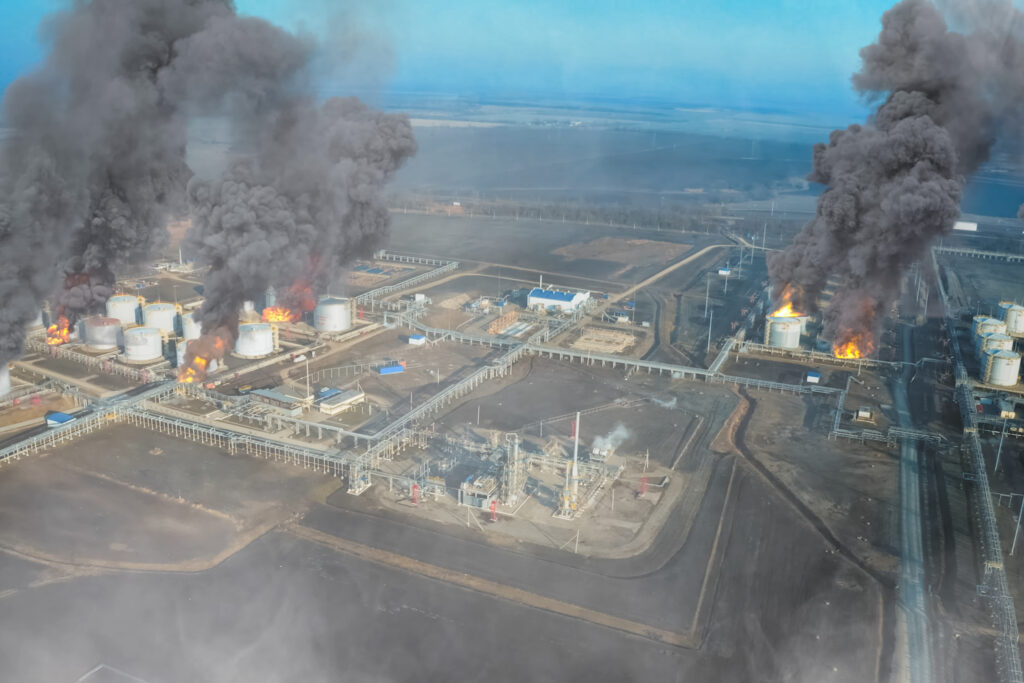Your cart is currently empty!
October 10, 2025

What Is Actually Happening
In the last few months, Ukraine has intensified its attacks on Russian oil infrastructure, primarily targeting oil refineries. The attacks began in the spring and summer of 2024, when Ukraine developed drones capable of reaching targets deep inside Russia. By 2025, Ukraine had significantly improved its drone capabilities—they can now fly farther and carry larger payloads. The frequency of drone attacks has also increased substantially. For example, the Volgograd refinery has been hit four times since August, the Novokuibyshev refinery three times, and the Saratov, Ryazan, and Salavat refineries twice each.
Most of the attacks are carried out by relatively small drones with limited payloads. As a result, only certain processing units or storage tanks at the refineries are typically damaged, and most facilities remain at least partially operational.
Russia’s total installed refining capacity is about 6.5 million barrels per day (MMbbl/d). In 2024, total oil production was 10.3 MMbbl/d, a 2.3% decline from 2023. In reality, Russia is currently refining around 5 MMbbl/d. Since August 2025, 16 Russian oil refineries have been attacked, representing around 38% of total installed capacity. However, the actual drop in refinery output is significantly smaller due to the low utilization rate of total capacity.
According to some estimates, since the attacks began in 2024, gasoline output has fallen by about 10%. Actual data on Russian gasoline production are not publicly available. There are fuel shortages in some regions, especially in areas lacking a retail network of major oil companies—for example, in occupied Crimea. In other regions, there are occasional shortages of high-grade gasoline.
Ukrainian drones mainly target primary refining capacity, particularly atmospheric distillation units. Russian refineries traditionally have surplus primary distillation capacity. It typically takes from a few weeks to several months to repair primary refining units, depending on the extent of the damage.
Russian Response
According to Incorrys analysis, the current impact of these attacks on Russia’s supply of refined products remains manageable. However, Russian authorities view the problem as serious. The government has imposed or extended bans on gasoline and diesel exports and is preparing to import gasoline and related petroleum products to cover domestic shortfalls. Fuel imports are expected to come from various countries, including Singapore. Belarus, for instance, has increased its exports of gasoline and diesel to Russia to help supply affected regions.
Russia has also proposed temporarily allowing the use of monomethylaniline (MMA or N-methylaniline) as an octane-boosting additive in gasoline to alleviate shortages of high-octane fuel grades. MMA was banned in Russia in 2016 for environmental and vehicle impact reasons, particularly in Euro-5 fuels.
At the same time, Russia is working to strengthen its air defense capabilities. However, given the country’s vast size, it is impossible to protect all refineries. The government has advised oil companies to install protective nets over distillation units and other equipment to shield them from drone attacks.
Conclusions
If the attacks on Russian refineries continue at the current pace, they could cause a significant shortage of refined fuels. These attacks also have major financial consequences, both in terms of repair costs and the expense of importing refined products. Fuel price at the pump may also increase.
However, there is a possibility that Russia and Ukraine could eventually agree to refrain from attacking each other’s energy infrastructure. Such discussions have reportedly taken place, but so far, Russia has refused to limit its offensive operations against Ukraine.
For more information, please contact:
References:
Soldatkin, Vladimir. “Russia’s oil output down 2.8%, gas production up 7.6% in 2024, deputy PM says.”, Reuters, January 30, 2025, https://www.reuters.com/markets/commodities/russias-oil-output-down-28-gas-production-up-76-2024-deputy-pm-says-2025-01-30/#:~:text=MOSCOW%2C%20Jan%2030%20(Reuters),2.8%25%20lower%20compared%20to%202023
Vakulenko, Sergei. “Have Ukrainian Drones Really Knocked Out 38% of Russia’s Oil Refining Capacity?”, Moscow Times, October 8, 2025, https://www.themoscowtimes.com/2025/10/08/have-ukrainian-drones-really-knocked-out-38-of-russias-oil-refining-capacity-a90756
Vovk, Roman. “Ukrainian Drone Strikes Disrupt 25% of Russia’s Oil Refining Capacity.”, Finway, October 2, 2025, https://finway.com.ua/en/ukrainian-drone-strikes-disrupt-russia

